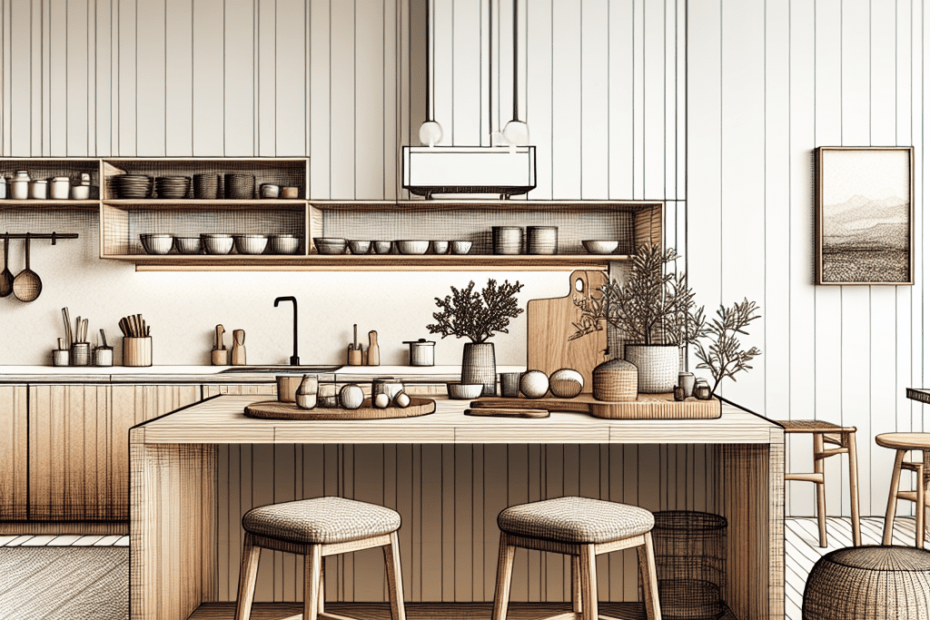“`html
The Essentials of Japandi-Inspired Kitchens
In recent years, homeowners and designers alike have been captivated by the calm, minimalistic beauty of Japandi kitchen design. With its roots in both Japanese and Scandinavian styles, Japandi seamlessly blends functionality with aesthetic simplicity, creating a tranquil space that promotes peaceful living. The merge of these two distinct styles creates a harmonious environment that is perfect for modern homes. In this article, they will explore the basics of creating a Japandi-inspired kitchen, which promises not only to look good but also to make everyday cooking a delightful experience.
Understanding Japandi Design
Japandi kitchen design is centered around two primary principles: simplicity and natural elements. By combining the sleek, minimal lines of Scandinavian design with the understated elegance of Japanese interiors, Japandi achieves a balance that feels both warm and refined. This style has captured the attention of many, partly due to its focus on sustainability and the use of natural materials.
Key Elements of Japandi Kitchen Design
Japandi design encourages the use of muted colors, natural materials, and simple furnishings. Here’s how these elements work together:
- Muted Colors: The color palette in a Japandi kitchen often includes whites, beiges, soft grays, and muted pastels. These colors create a calming environment where the eye can find rest.
- Natural Materials: Wood, stone, and bamboo are preferred materials. They bring nature into the home, creating an organic feel that complements the minimalistic approach.
- Simple Furnishings: Furniture pieces are traditionally functional, with clean lines and minimal ornamentation.
- Decluttered Space: One of the critical aspects of Japandi design is reducing clutter. Storage solutions are often built-in and hidden to maintain a clean and open space.
Statistics on the Popularity of Japandi Design
According to Elle Decor, searches for Japandi interior design have increased by 500% over the past two years. This surge indicates a growing interest in homes that prioritize calmness and efficiency, particularly in essential areas like the kitchen. Additionally, a survey revealed that 40% of millennials prefer minimalist designs over more traditional decor, strengthening Japandi’s popularity among younger generations.
Creating a Japandi Kitchen
They can create a Japandi kitchen by focusing on a few specific strategies:
- Focus on Lighting: Natural lighting is central to Japandi design. Large windows or skylights can enhance sunlight, while simple, elegant light fixtures can add auxiliary lighting for dark areas.
- Integrate Plants: Small indoor plants add a touch of green that softens the space, adding life to the kitchen without overtaking the minimal aesthetic.
- Invest in Quality Materials: As Japandi design values quality over quantity, choosing well-crafted cabinetry and durable countertops is essential. Stone and wood are both excellent choices that align with the natural theme.
- Blend Functionality and Beauty: With appliances and kitchen tools, they should aim for both usability and visual cohesion with the rest of the kitchen. Items should be easy to access yet stored in a way that doesn’t clutter the workspace.
Benefits of Japandi Kitchen Design
The Japandi style offers numerous benefits that make it an appealing choice for a kitchen remodel:
| Benefits | Description |
|---|---|
| Tranquility | A minimalist design promotes a calm, serene environment. |
| Functionality | Organized and efficient use of space makes cooking easier and more enjoyable. |
| Timelessness | This style is not overly trendy, meaning it won’t feel outdated quickly. |
| Sustainability | Use of natural materials can reduce environmental impact. |
Potential Drawbacks
While Japandi kitchens have much to offer, they may not be everyone’s cup of tea. The simplicity of design may feel too sparse for those who prefer a more vibrant or eclectic style. Additionally, maintaining the minimalist aesthetic requires regular decluttering and organization, which may not suit all lifestyles.
Key Takeaways
- Japandi kitchen design merges Japanese and Scandinavian aesthetics to create a tranquil and minimalistic space.
- The style emphasizes the use of natural materials like wood and stone, muted color palettes, and simple furnishings.
- The popularity of Japandi design has grown significantly, especially among younger generations seeking functionality and calmness.
- Japandi kitchens offer numerous benefits, including a focus on sustainability, functionality, and timeless design.
- Regular maintenance and organization are necessary to preserve the minimalist look.
FAQ Section
- What is Japandi kitchen design?
- Why is Japandi design so popular?
- What colors are used in Japandi kitchens?
- Are Japandi kitchens practical?
- How can I incorporate Japandi design into my existing kitchen?
Japandi kitchen design combines Japanese and Scandinavian elements to create a minimalist and functional space characterized by natural materials and muted colors.
Its popularity stems from a rising interest in minimalistic and sustainable living, as well as its calming effect due to the use of natural elements and simple designs.
Common colors include whites, beiges, soft grays, and muted pastels that promote a serene environment.
Yes, they offer a highly functional and organized space, combining beauty and utility in kitchen usage.
Start by decluttering, incorporating natural materials, focusing on a muted color scheme, and investing in quality, functional furnishings.
“`
